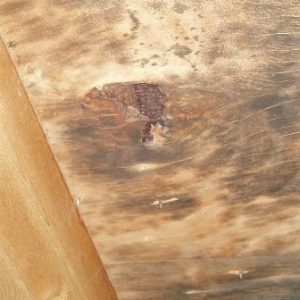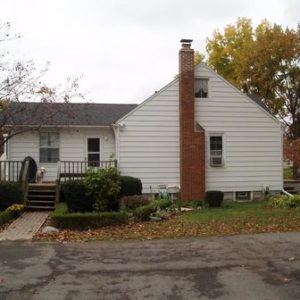I have a question for you guys and maybe you can give me an idea of what my husband and I should do, if anything.
When my husband bought his house, about 5 years ago, he had it inspected. During the inspection, they noticed that there was mold growing on the underside of the roof boards (visible from the attic). Apparently the house needed to be re-roofed. To add to the problem, it turned out that the roof was not properly vented either. So when the new roof was put on, they also included a new ridge vent.
(edited: They did not replace the roof boards, but they did tear off the old shingles before putting on the new ones)
I don’t think they did anything to actually “kill” the mold when they did the work. I think they just tried to correct the moisture and venting problem.
Well, it’s been 5 years since then and we haven’t really looked up there in awhile. So we looked up there a few nights ago and we still see black stuff on the roof boards. I took some pictures and thought I’d see what you guys thought.
Does mold just go away (stop growing) if you fix the moisture problem or does it need to be “killed?”
We are currently undergoing a major home renovation but we were planning on being able to keep the existing roof intact. Should we just buck up and rip off the roof to replace the roof boards or is there some other way we can fix the problem? Or is it even a problem at all? Could it be possible that the roof boards are just permanently stained but that the mold isn’t growing anymore?
The last picture shows the side view of the house. It’s the back part of the roof I’m referring to.
Thanks!
-Kacy
Edited 2/10/2005 9:34 am ET by kcmarie122

























Replies
>> Does mold just go away (stop growing) if you fix the moisture problem ...
It stops growing, but what's already there doesn't evaporate, it just goes dormant. There's no need to remove anything unless the spores are irritating someone, in which case just vacuuming up any loose material should be adequate. Use a HEPA filter to avoid spreading the spores around.
>> ... or does it need to be "killed?"
Spores are very difficult to kill, and even if you could kill them, more of them would just float in from other sources. They're everywhere. There's no need to remove all traces of the mold. Keeping the area dry will keep it from growing.
To add to what Uncle Dunc said....
If the sheathing is still sound, there is no reason to be removing the roof to replace it. Take a scrub brush and some soap and water and clean the surface of the board (put plastic down to catch the drips) if you want to. Then you would be able to easily tell if the mold is recurring or if it is the old mold sitting there dormant.
I take it that the roof was leaking when you bought the house and that the leak was blamed as the source of the moisture for the mold?
Given the extent of the mold I find it a little hard to believe that a roof leak was responsible.
I wonder if you have too much moisture entering the attic from the living area. Does this house have a basement or a crawlspace?
Mold requires three things to grow: food, temperature, and water. Your house is largely made of stuff that mold considers food, so not much can be done about that. The temp mold likes is pretty much normal temps that we like (and when extremes come along, the mold just goes dormant until better temps arrive), so not much can be done there.
So the issue is moisture. The most common sources of moisture in a house are showers and baths, laundry, dishwashing, cooking and people breathing. One other potentially very big contributor is the basement or crawlspace (or even the slab sometimes). Another is humidifiers.
Then there is the issue of how the moisture gets to the attic.
If you look into the Energy, Heating, and Insulation folder and scroll through looking for threads on attic insulation and crawlspace or basement (depending on what you have) insulation you will find out a lot.
I would begin by cleaning as much of that mold up so I could then see if it was coming back or not.
Rich Beckman
Another day, another tool.
Well, part of our house has a basement, but under that portion of the roof it is a crawlspace (the crawlspace is open/connected to the basement part though). Our basement is pretty damp though.
We don't have a humidifier in our house so that can't be it. It could be because we don't have a bath fan for our 1 bathroom and also we don't have a dishwasher so we are constantly washing dishes with hot water? Could that do it?
Another factor is that we don't have central air conditioning and we have pretty warm, humid summers. Could that be a factor at all? Or would that just make the situation worse?
Thanks for your advice!
-Kacy
Damp basement, damp crawlspace, damp attic. Fix the foundation dampness, and the attic will probably be fixed along with it. Check out the old FHB articles by Fred Lugano and Mark Rosenberg on the main site. You might have to buy them, but as Fred's former editor, I can assure you it would be money well spent.
AndyAndy Engel
Senior editor, Fine Woodworking magazine
Other people can talk about how to expand the destiny of mankind. I just want to talk about how to fix a motorcycle. I think that what I have to say has more lasting value. --Robert M. Pirsig
I would clean up as much of the mold as I could, so I would be able to monitor whether it comes back.You should have an exhaust fan in the bathroom that exhausts the air completely out of the house (not into the attic!!).And the damp basement is not helpful. The first question is how is water handled outside of the house?Is the ground sloped away from the house? Or towards the house? Do the downspouts move the water away from the house or dump it at the base of the wall?It might be a good idea to seal the crawlspace floor with plastic. Lots of people use this product:http://www.energyfederation.org/consumer/default.php/cPath/21_933_68
If you have lots of water down there, you may need a sump pit and pump.Rich BeckmanAnother day, another tool.
Thanks for your comments Guys.
I think that the damp basement is probably our biggest problem. It used to be terrible but we put in a bead dry system a few years ago. It allows the water to drain to a sump well that pumps it out. That has helped a lot but it is still damp because we still haven't covered up the pea gravel with concrete yet. We wanted to make sure it worked before we did it. Well, that was 3 years ago...
Our basement is very old, built in the 30's. So it definitely does not have the proper drainage outside either. We are doing a major remodel/addition to our house which involves adding on new basement area. This new basement is actually deeper than the existing basement and will definitely have all the correct drainage systems in place. This should help a lot.
We are also re-grading around the whole house and yard so that also should help.
Good tips and information! I never would have associated the damp basement with a damp attic. Thanks so much!
-Kacy
Cover the crawl floor asap - for moisture purposes, plastic sheeting will do.As noted, The mold on the roof sheathing is a result of the wet crawl space.The only attic picture of significant concern in my opinion is #4 - betcha that's on the north roof slope over the craw.Personally, I'd have to be incredibly bored before doing any cleaning up there - it's highly unlike air with mold would move from the attic down into the living area of the house. If by any chance there is a return duct in the attic (unlikely with that style house) be sure it is well sealed.I'd also consider cleaning if I had an infant in the house. She the EPA web site for tips on cleaning. Don't spray bleach up there unless you're wearing a good respirator. (Spraying bleach is likely to be higher risk than the mold!)I think the "biggest" concern (based on the photos and discussion) is resale.Do a better job of documenting what's there now - identifying where shots have been taken - for later comparisons.
View Image
Sojourners: Christians for Justice and Peace
" That has helped a lot but it is still damp because we still haven't covered up the pea gravel with concrete yet."I could be mistaken, but I'll bet it would be a very good idea to put down a sturdy vapor barrier on the pea gravel before pouring the concrete.Rich BeckmanAnother day, another tool.
Very good idea! Thanks for that! We probably wouldn't have thought of it!
-Kacy
I've heard that fumigation for termites will also kill dry rot fungus. Is that true? Would it kill mold, too?
-- J.S.
Yes, the termite spray will kill the mold if the spray is a boron compound - otherwise no!